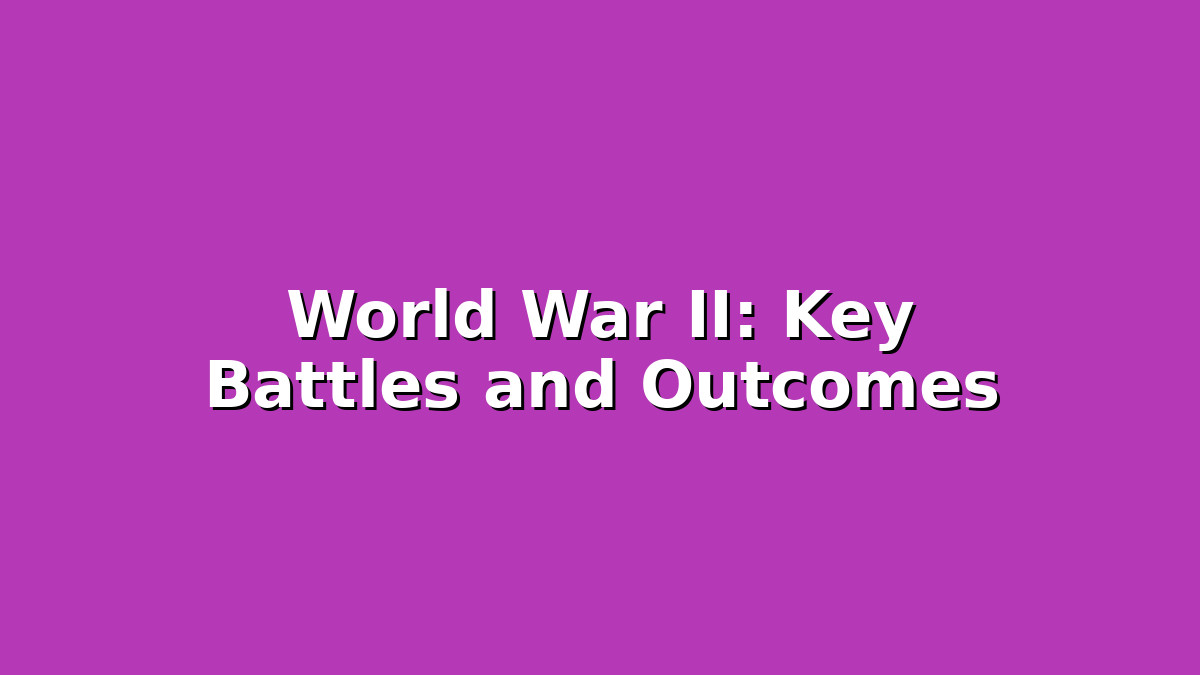World War II remains one of the most significant events in modern history, shaping the political, social, and economic landscape of the world. For students preparing for exams, understanding the key battles and their outcomes is crucial not only to grasp the flow of the war but also to appreciate its impact on global history. This article breaks down some of the most important battles of World War II, offers study tips to help you retain information, and encourages you to approach your exam preparation with confidence and focus.
Understanding the Importance of Key Battles in World War II
Before diving into the battles themselves, it’s important to understand why these specific confrontations matter. World War II was fought across multiple continents and involved many nations, but a handful of battles turned the tide, determining the ultimate outcome of the war. These battles also demonstrate how different strategies, technologies, and leadership styles influenced the course of history.
When studying these battles, it’s helpful to look at them not just as isolated events but as interconnected actions that shaped the final outcome. Try to visualize the timeline and geography of the war, which aids in retaining details and understanding cause and effect.
1. The Battle of Stalingrad (August 1942 – February 1943)
The Battle of Stalingrad is often considered the turning point on the Eastern Front and one of the deadliest battles in human history. This brutal confrontation between Nazi Germany and the Soviet Union marked the beginning of a major shift in momentum.
Why It Matters:
– The German army suffered its first major defeat, which halted its advance into the Soviet Union.
– The Soviet victory boosted morale and gave the Allies hope for eventual victory.
– It marked the start of the Soviet push westward, eventually leading to the fall of Berlin.
Study Tip:
Make a timeline chart detailing the key phases of the battle—from the initial German offensive, the Soviet encirclement, to the eventual German surrender. This visualization helps you remember the sequence and significance of events clearly. Additionally, use maps to track troop movements which can make the battle easier to understand and recall.
2. The Battle of Midway (June 1942)
The Battle of Midway was a pivotal naval battle in the Pacific Theater. The United States Navy managed to surprise and decisively defeat the Japanese fleet, severely weakening Japan’s carrier strength.
Why It Matters:
– It stopped Japanese expansion in the Pacific and shifted the balance of naval power to the Allies.
– The battle demonstrated the importance of intelligence and code-breaking in warfare.
– It set the stage for the Allied island-hopping campaign toward Japan.
Study Tip:
Focus on cause and effect by noting how intelligence breakthroughs, such as breaking the Japanese naval code, directly influenced the outcome of the battle. Create flashcards for key terms like “carrier,” “code-breaking,” and “island-hopping” to build your vocabulary and recall important concepts quickly. Also, summarizing the battle in your own words helps reinforce understanding.
3. D-Day: The Normandy Invasion (June 6, 1944)
D-Day was the largest amphibious invasion in history, marking the beginning of the liberation of Western Europe from Nazi occupation. Allied forces landed on the beaches of Normandy, France, in a massive coordinated effort involving American, British, Canadian, and other Allied troops.
Why It Matters:
– It opened a crucial second front against Germany, relieving pressure on the Soviet forces in the East.
– The success of D-Day led to the rapid liberation of France and eventually the defeat of Nazi Germany.
– It showcased the value of planning, cooperation among Allies, and sheer determination.
Study Tip:
Use mnemonic devices to remember the five beaches involved in the landing (Utah, Omaha, Gold, Juno, Sword). Practice writing short essays explaining why D-Day was a turning point. This exercise helps improve your ability to communicate historical analysis, which is often tested in exams.
Additional Study Tips for Mastering World War II Topics
– Use Timelines and Maps: Visual aids are incredibly helpful for understanding the chronology and geography of the war. Try creating your own timelines or maps as an active learning exercise.
– Practice Past Exam Questions: Look for exam questions on World War II battles and outcomes. This helps you get familiar with the type of questions you might face and how to answer them effectively.
– Group Study: Discussing these battles with classmates can deepen your understanding and reveal new perspectives you may not have considered. Teaching others is a powerful way to reinforce your own knowledge.
– Connect Battles to Outcomes: Always try to link battles with their larger impact on the war. Understanding why a battle was important helps you remember specific details better.
Conclusion
Studying World War II’s key battles and outcomes can seem overwhelming due to the vast amount of information. However, by focusing on major turning points like the Battle of Stalingrad, the Battle of Midway, and D-Day, you can gain a solid foundation that will serve you well in exams and beyond. Use timelines, maps, flashcards, and practice questions to make your study sessions more effective and engaging. Remember, exam preparation is a journey—stay consistent, take breaks, and believe in your ability to succeed. With the right approach, you’ll not only remember these critical events but also appreciate their profound impact on the world we live in today.
Good luck with your studies!

Responses